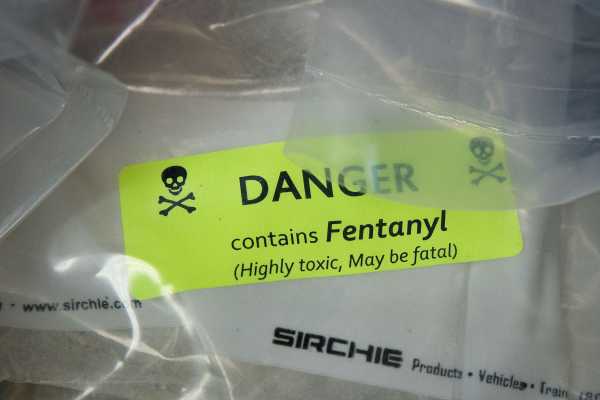
In conversations about drug legalization, supporters argue that the government could regulate drugs in order to mitigate the potential risks of making the substances legal — whether it’s more misuse, addiction, overdoses, or drug-related crime. This was a key point against Prohibition (of alcohol) in the 1920s and ’30s, and it’s a key point against marijuana prohibition and even against the prohibition of any drug, all the way up to heroin, today.
But a New York Times story by Emily Baumgaertner published last week offers a reminder that this isn’t how drug regulation often works in the real world.
The story looked at regulation by the Food and Drug Administration (FDA) of a fast-acting version of fentanyl. The synthetic opioid is extremely potent, and it’s historically been used for breakthrough cancer pain that overwhelms other opioids. But over the past few years, pharmaceutical companies have lobbied doctors to prescribe the drug more often — for more typical, less severe problems like migraines and backaches. And the FDA, based on the Times report, has done little to stop such marketing and excess off-label prescribing.
Baumgaertner reported for the Times:
For pharmaceutical companies, the profit interest here is obvious: more prescriptions, more money.
But the results can be deadly. One example from the Times: “Carolyn Markland of Jacksonville, Fla., wanted to be able to lift her grandchildren despite a degenerative spinal disease. Her doctor prescribed a dose of Subsys to her in July 2014. Ms. Markland suffered respiratory distress the following morning and died of drug toxicity, according to court documents.”
The FDA told the Times that the limited data it got from stakeholders, such as prescriber surveys, insurance claims, and industry reports, made it difficult to gauge the problem and react accordingly. The FDA’s chief, Scott Gottlieb, also said in a statement that it would take the issue to an advisory committee.
According to the Times and NBC News, one of the FDA’s expert panels met on Friday to discuss and review the agency’s regulatory strategy for these fentanyl products, known as transmucosal immediate-release fentanyl. The Johns Hopkins researchers who uncovered the FDA’s inaction testified at the panel. It’s so far unclear what will come out of the review.
Because it’s so potent, fentanyl is typically reserved for patients who are tolerant of opioids and have severe flashes of pain that overwhelm more standard opioids already being taken. In the cases that resulted in deaths, patients often weren’t opioid-tolerant — so they couldn’t handle the potent opioid they were given — and had more minor pain than fentanyl is intended for.
We are in the middle of an opioid epidemic, the deadliest drug overdose crisis in US history. This, one would think, would be the most obvious time for the government to step up its regulation of drugs and especially opioids. Yet the FDA, despite having the powers to do so, essentially took no action to regulate what was fairly clear misuse of one of the most potent opioids on the market. In fact, the federal agency essentially folded to the industry — giving drug companies power in deciding how their product should be used and regulated.
As I’ve written before, I used to support legalizing all drugs. The opioid epidemic changed my mind on the issue — by showing me that maybe my vision of sensible drug regulation in a world where everything from marijuana to heroin was legalized was not based in reality.
The Times’s report helps explain my shift. Companies got ahold of a dangerous, addictive product, marketed it irresponsibly, and lobbied for lax rules. The government’s regulatory response floundered. The government even worked with drug companies. And people got addicted and died.
This isn’t atypical for the US. Regulatory capture, when regulators are over time controlled by the industries they’re regulating, was a key cause for the broader opioid epidemic, as it has been for other drug problems throughout US history. And it should give people pause about the government’s ability to regulate away the worst risks involved with drugs should more be legalized.
Drug regulators often fail
The FDA has made this mistake before. The Times report noted that the FDA previously “tasked Purdue Pharma in the early 2000s with leading a risk management program for OxyContin, its own product.” Purdue and OxyContin are now widely blamed for the opioid epidemic, because widespread marketing for the opioid convinced many prescribers that opioids were safe and effective for treating pain — leading to a lot of overprescribing.
Kathleen Frydl, a drug policy historian, previously summarized some of the FDA’s other failures in the opioid crisis:
Other federal agencies have similarly failed. The Drug Enforcement Administration has the power to set production quotas for some opioids produced for sales, like hydrocodone and oxycodone. It could have used this power, as it did during past drug crises, to limit the supply of these dangerous drugs. Instead, the DEA let the production quota explode — only recently taking action as the opioid crisis has drawn more national attention.
Much of this is the result of aggressive lobbying from pharmaceutical companies. Over the past decade, opioid producers and suppliers have spent hundreds of millions of dollars at the federal and state level lobbying lawmakers to stop new regulations on their drugs, while calling on policymakers to actually loosen access to painkillers.
In fact, the DEA admits that pharmaceutical companies played a key role in its decision-making in its own statements. Here is the agency in 1999 after an unnamed company asked for a formal hearing about the quotas: “In addition, one company requested a hearing to address the aggregate production quota for oxycodone (for sale) or hydromorphone if the aggregate production quotas were not increased sufficiently. The DA [sic], based on the date [sic] provided, has increased the aggregate production quotas for both oxycodone (for sale) and hydromorphone and has determined that a hearing is not necessary.”
The company didn’t even have to take part in a formal hearing to get what it wanted from the DEA.
This is part of a broader historical pattern in how the US regulates drugs.
Consider cigarettes. Sure, smoking rates have come down by nearly three-fourths in the past five decades, in large part thanks to government efforts like higher taxes on cigarettes and stricter enforcement of smoking age laws. But despite these efforts, smoking still kills an astonishing 480,000 people each year by some estimates and 540,000 by others. It would take roughly 30 years of murders, at the 2015 rate, to kill this many Americans.
That government regulators allowed the tobacco epidemic to get this bad before they finally took strong action from the 1960s to ’90s speaks to just how badly the US can botch drug regulation. And much of that was a result of lobbying and misinformation by tobacco companies.
Then there’s alcohol. By the latest estimate, excessive drinking is linked to about 88,000 deaths and millions of hospitalizations each year. If anything, this seems to be getting worse: As opioid overdose deaths have risen, so too have alcohol-related deaths. And while experts have all sorts of ideas (including something as simple as raising alcohol taxes) to combat alcohol misuse and death, lawmakers and regulators have failed to do much of anything — in large part because alcohol companies aggressively lobby them not to, blocking anything from higher taxes to nutrition labels. (Congress actually cut alcohol taxes last year following lobbying from beverage companies.)
These drugs are dangerous and kill people, but Americans and policymakers have been slow to do anything about it, with powerful for-profit interests standing in the way.
In a world where all drugs are legalized, what’s to stop a legal marijuana, cocaine, or heroin company from achieving the same results?
A frustrating middle ground for drug policy reform
I am not the first to tie the failures of the opioid epidemic to the risks of drug legalization. For RealClearPolicy, Robert VerBruggen wrote that the opioid epidemic has forced him to confront some of his libertarian views on legalization. While he “was never so naïve as to think there would be no increase in drug use or abuse if drugs were legal,” he ultimately figured the cost-benefit analysis would land in favor of legalization and against prohibition.
“But,” he added, “it sure looks like loosening control of a drug made all hell break loose, and that’s not what I would have predicted, say, ten years ago.”
Similarly, Ethan Nadelmann, the retired executive director of the pro-reform Drug Policy Alliance, previously told me that the opioid epidemic “should give you pause” in terms of backing full, free market legalization.
That’s not to say that all drug policy reform is a bad idea; far from it.
For one, I think marijuana legalization is probably fine. It’s already a bit out of the bottle, since nine states — including California, the wealthiest and most populous in the country — and Canada have legalized cannabis. While there are real concerns with pot addiction and people doing stupid things on weed, my perspective is that it’s such a relatively harmless drug, according to the best scientific evidence, that the government can afford to screw it up. Especially since the alternative is a prohibition regime that leads to hundreds of thousands of needless arrests in the US each year and fosters violence as traffickers fight over turf or settle other beefs related to the drug trade.
There’s also little argument that America has been excessive in its punishment for drugs. From the harsh mandatory minimum sentences to the three-strikes laws that can get someone life in prison for drugs to the overly strict probation and parole rules that can get someone thrown back into prison for little more than possession, the US has a lot of room to reduce punishment.
The research, after all, shows these punishments aren’t effective. A 2014 study from Peter Reuter at the University of Maryland and Harold Pollack at the University of Chicago found there’s no good evidence that tougher punishments or harsher supply elimination efforts do a better job of driving down access to drugs and substance misuse than lighter penalties. So more severe penalties don’t do much, if anything, to slow the flow of drugs.
As drug policy experts emphasized in a piece I reported out in 2016, there’s a lot of room for the US to relax its severity of punishment before legalization. One possibility is essentially the Portuguese model: Drugs are decriminalized for personal use, so you can’t be punished with prison time merely for possessing or using illegal substances like cocaine and heroin. But the drugs remain illegal for big companies to produce and sell for profit — effectively stopping the kind of commercialization that’s spurred the tobacco, alcohol, and opioid epidemics.
There’s also room for way more public health efforts to deal with drugs. As a landmark report from the surgeon general made clear in 2016, plenty of places across America could use more access to addiction treatment; only 10 percent of people with a drug use disorder get specialty treatment, largely due to a lack of affordable and available treatment options in many areas.
There are also some more experimental policies. Several countries, including Canada, have successfully tested prescription heroin as an addiction treatment for opioid users who have been unable to shake off their addiction through other forms of treatment. While I’m wary of the US government’s ability to oversee a program like this, the evidence is strong enough in other nations that it’s at least worth trying out here.
A milder form of prohibition won’t solve all our drug problems. But as with many policy debates, this is about picking between a bunch of unsatisfactory options. Faced with an excessively harsh criminal justice system or a legal industry that carelessly causes drug epidemics, perhaps that frustrating middle is the best we can hope to do.
As Keith Humphreys, a drug policy expert at Stanford University, once told me, “There’s always choices. There is no framework available in which there’s not harm somehow. We’ve got freedom, pleasure, health, crime, and public safety. You can push on one and two of those — maybe even three with different drugs — but you can’t get rid of all of them. You have to pay the piper somewhere.”
The New York Times report exposes the costs that come when a drug is legalized and sold by for-profit companies. It should make us cautious of accepting those costs for even more drugs.
Sourse: vox.com






